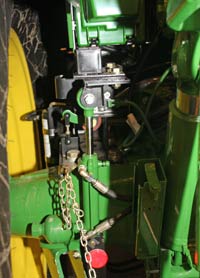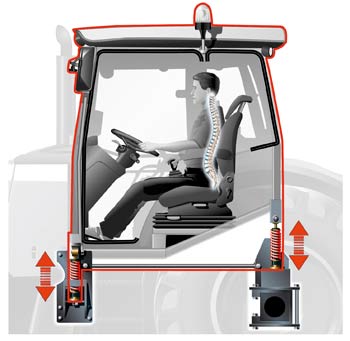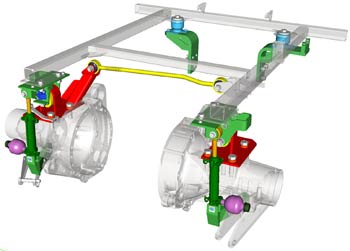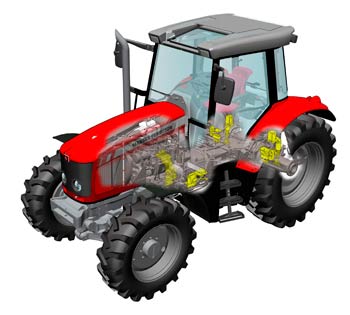Cab suspensions are becoming the norm

Cab suspension is fast becoming a must-have option when farmers buy a new tractor, reports Andy Collings
Tractor work will never be the smoothest of tasks – the terrain they are asked to work in is rarely the stuff billiards are played on.
But, increasingly, there is recognition that improved operator comfort means greater output. Where there is choice, operators will consciously or otherwise limit their tractor speed to one which allows an acceptable degree of comfort. Introduce cab suspension, front axle suspension and sprung seats and speed increases along with output – by as much as 12%, say tractor manufacturers.
Efforts to increase the comfort of tractor drivers through the use of suspension have also been driven by legal pressure to reduce whole-body vibration which has the potential to cause health problems when tractors are operated for long periods of time. The good news is that most tractor manufacturers are now able to offer customers the option of cab suspension.
Tractor drivers are subject to forces in three planes – up and down, side to side, and back and forwards. Suspension designers try to limit these movements so they have the least effect on a human body.
In an ideal world such movements would be reduced to zero. But an operator completely deprived of sensory input as to how his tractor was performing would be liable to over-confidence and probably soon turn the tractor over.
So a degree of cab movement is required – but how much or little should this be? Some cab designers have got this wrong in the past, with tractor drivers complaining of motion sickness.
Also, tractor cabs are built to provide protection for the operator and it is important that suspension systems do not compromise this essential safety aspect.
So how have manufacturers set about providing cab suspension? There are basically three ways of controlling the movement required to dampen out the forces imposed on the cab – spring, air and hydraulic (via a gas accumulator).
In the UK, where on-board air compressors are still relatively rare, air suspension is not normally offered though, with greater use of trailer air braking systems, this situation could change.
More common is the use of springs and shock absorbers or hydraulic/gas accumulator systems.
An example of a hydraulic cab suspension system is John Deere’s HCS option. As with most systems, it is only the rear of the cab which has the suspension units – the front is connected to the chassis using pivot-type bearings on each corner which allow a small amount of lateral and longitudinal movement.
At the two rear corners, connection is made using two interconnected brackets which, while being secure, allow the rear of the cab to move up and down.
This movement is controlled by two hydraulic rams/shock absorbers feeding oil into two nitrogen-filled accumulators – the compressibility of the gas provides the suspension element for a movement of 50mm up and 50mm down.
To ensure the ride height remains in a central position – irrespective of the weight of the operator – a position sensor increases or decreases the amount of oil in the shock absorber rams.
Most other tractor manufacturers take the spring/shock absorber route. Claas, with its Renault heritage, probably has more experience than most – the Renault TZ suspended cab was introduced in the 1980s.
Unlike the Deere system, the Claas Arion cab has suspension spring and shock absorbers at all four corners of the cab – rather than just the two rear ones. It is an arrangement designed to reduce not only vertical movement but also side-to-side and forward-and-backward movement.
Left to its own devices, the system would cause rolling and pitching so roll bars run across the cab from front to rear. There’s also an integral three-position adjustment system that allows either a firmer or softer ride to be set.
Cab suspension is increasingly available for smaller tractors. Massey Ferguson, for example, recently announced cab suspension for its 85-145hp MF5400 Series tractors and Deutz-Fahr has been offering suspension on its 90-120hp Agrotron K Series tractors since their launch in 2005.
What does the future hold? New Holland‘s Richard Hollins thinks big improvements in cab suspension will only come when manufacturers introduce new cabs which can be designed to accommodate suspension units.
“Many manufacturers still use cabs that have had to be adapted to have suspension units fitted,” he says. “This inevitably leads to a degree of compromise and gives little choice in the positioning of the springs and dampers.”
Mr Hollins suggests that, as with the later New Holland tractors where a new cab frame has been introduced, the suspension unit can be positioned further under the cab where a greater degree of control is available.
“This helps to provide a more complete suspension system but it is still not perhaps the absolute solution,” he insists. “The interaction between the operator, the seat, the cab and the rest of the tractor is a complex one, with cab suspension being just one part of it.”
John Deere
John Deere’s cab suspension is based on a hydro-pneumatic system. Note the position sensor which keeps the system at mid-height – irrespective of the weight it in the cab.
Class system by Renault
Claas uses the system developed by Renault and is the only tractor manufacturer to mount spring and shock absorbers on four corners of the cab, rather than the more usual two.
 |
|---|
| The system used by Class is developmed by Renault. |
John Deere HCS system
Schematic view of the John Deere HCS system. Main components comprise hydraulic ram and gas accumulator along with the position sensor. The yellow strut is known as the Panhard rod which prevents excessive lateral movement.
Class four-spring system
A look at the Claas four-spring system and the struts which maintain the stability of the cab.
Class and Renault
Claas inherited Renault’s cab experience when it took over the French maker.
 |
|---|
| Class has benefitted from Renault’s experience. |
MF 5400 tractor series
Massey Ferguson now offers cab suspension for its 85-145hp MF 5400 Series tractors.
 |
|---|
| The MF 5400 series offers cab suspension. |

